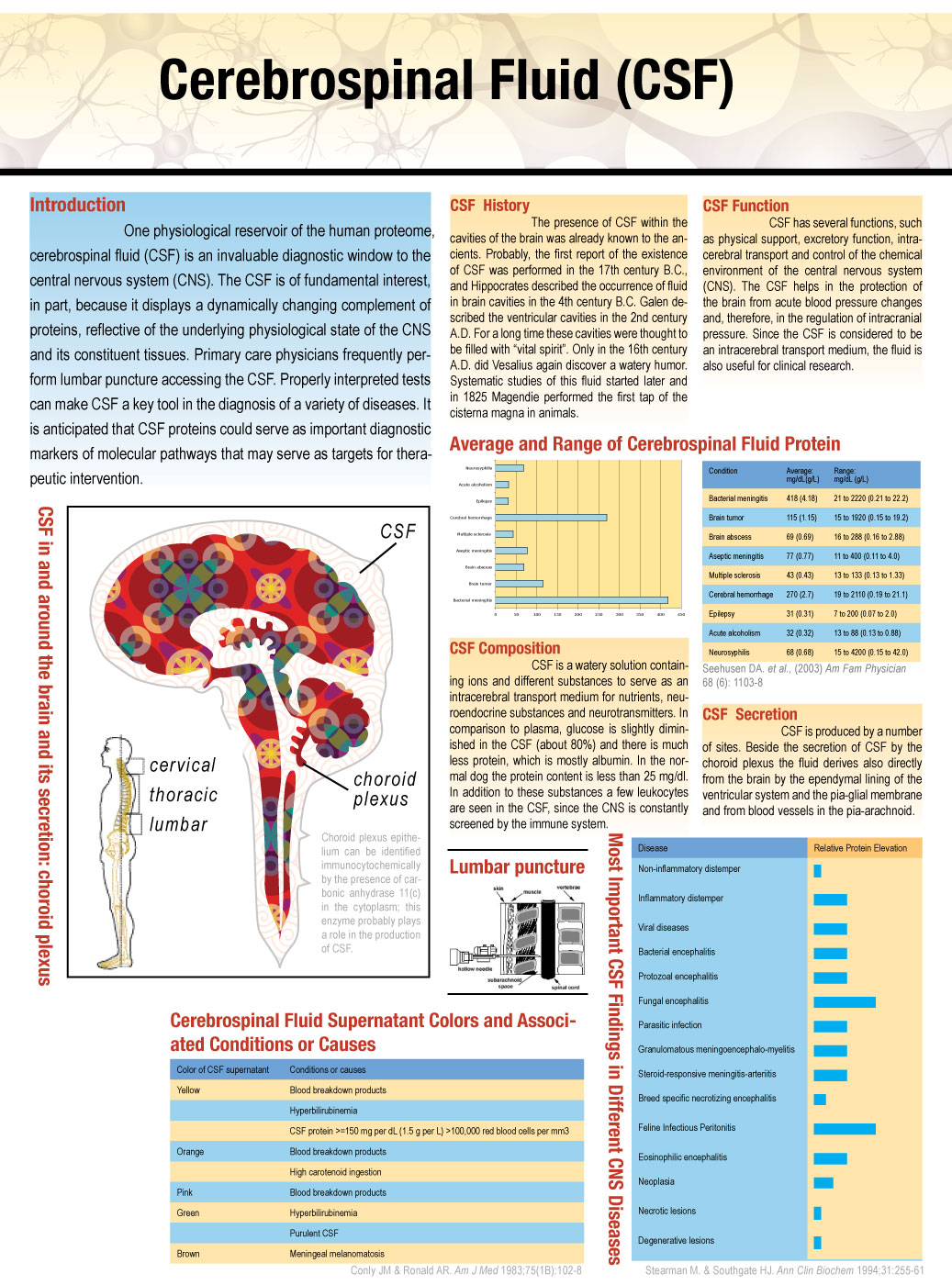Cerebrospinal fluid

Editor-In-Chief: C. Michael Gibson, M.S., M.D. [1]
Overview
Cerebrospinal fluid (CSF), Liquor cerebrospinalis, is a clear bodily fluid that occupies the subarachnoid space and the ventricular system around and inside the brain. Essentially, the brain "floats" in it.
More specifically the CSF occupies the space between the arachnoid mater (the middle layer of the brain cover, meninges) and the pia mater (the layer of the meninges closest to the brain). Moreover it constitutes the content of all intra-cerebral (inside the brain, cerebrum) ventricles, cisterns and sulci (singular sulcus), as well as the central canal of the spinal cord.
It is an approximately isotonic solution and acts as a "cushion" or buffer for the cortex, providing also a basic mechanical and immunological protection to the brain inside the skull.
Circulation
It is produced in the brain by modified ependymal cells in the choroid plexus. It circulates from the choroid plexus through the interventricular foramina (foramen of Monro) into the third ventricle, and then through the cerebral aqueduct (aqeduct of Sylvius) into the fourth ventricle, where it exits through two lateral apertures (foramina of Luschka) and one median aperture (foramen of Magendie). It then flows through the cerebromedullary cistern down the spinal cord and over the cerebral hemispheres.
Traditionally, it has been thought that CSF returns to the vascular system by entering the dural venous sinuses via the arachnoid granulations. However, some[1] have suggested that CSF flow along the cranial nerves and spinal nerve roots allow it into the lymphatic channels; this flow may play a substantial role in CSF reabsorbtion, particularly in the neonate, in which arachnoid granulations are sparsely distributed.
Amount and constitution
The cerebrospinal fluid is produced at a rate of 500 ml/day. Since the brain can only contain from 135-150 ml, large amounts are drained primarily into the blood through arachnoid granulations in the superior sagittal sinus. This continuous flow into the venous system dilutes the concentration of larger, lipoinsoluble molecules penetrating the brain and CSF. [2]
The CSF contains approximately 0.3% plasma proteins, or 15 to 40 mg/dL, depending on sampling site. [3] CSF pressure ranges from 60 - 100 mmH2O or 4.4 - 7.3 mmHg, with most variations due to coughing or internal compression of jugular veins in the neck.
Function
The cerebrospinal fluid has many putative roles including mechanical protection of the brain, distribution of neuroendocrine factors and prevention of brain ischemia. The prevention of brain ischemia is made by decreasing the amount of cerebrospinal fluid in the limited space inside the skull. This decreases total intracranial pressure and facilitates for blood perfusion.
Pathology
When CSF pressure is elevated, cerebral blood flow may be constricted. When disorders of CSF flow occur, they may therefore affect not only CSF movement, but also the intracranial blood flow, with subsequent neuronal and glial vulnerabilities. The venous system is also important in this equation. Infants and patients shunted as small children may have particularly unexpected relationships between pressure and ventricular size, possibly due in part to venous pressure dynamics. This may have significant treatment implications but the underlying pathophysiology needs to be further explored.
CSF connections with the lymphatic system have been demonstrated in several mammalian systems. Preliminary data suggest that these CSF-lymph connections form around the time that the CSF secretory capacity of the choroid plexus is developing (in utero). There may be some relationship between CSF disorders, including hydrocephalus and impaired CSF lymphatic transport.
Diagnosis and therapy
Cerebrospinal fluid can be tested for the diagnosis of a variety of neurological diseases. It is usually obtained by a procedure called lumbar puncture in an attempt to count the cells in the fluid and to detect the levels of protein and glucose. These parameters alone may be extremely beneficial in the diagnosis of subarachnoid hemorrhage and central nervous system infections (such as meningitis). Moreover, a cerebrospinal fluid culture examination may yield the microorganism that has caused the infection. By using more sophisticated methods, such as the detection of the oligoclonal bands, an ongoing inflammatory condition (for example, multiple sclerosis) can be recognized. A beta-2 transferrin assay is highly specific and sensitive for the detection for e.g. cerebrospinal fluid leakage.
Lumbar puncture can also be performed to measure the intracranial pressure, which might be increased in certain types of hydrocephalus. However a lumbar puncture should never be performed if increased intracranial pressure is suspected because it could lead to brain herniation.
This fluid has an importance in anethesiology. Baricity refers to the density of a substance compared to the density of human cerebral spinal fluid. Baricity is used in anesthesia to determine the manner in which a particular drug will spread in the intrathecal space.
Interpretation of Lumbar puncture
| Cause | Appearance | Polymorphonuclear cell | Lymphocyte | Protein | Glucose |
|---|---|---|---|---|---|
| Pyogenic bacterial meningitis | Yellowish, turbid | Markedly increase | Slightly increase or Normal | Slightly increase or Normal | Decrease |
| Viral meningitis | Clear fluid | Slightly increase or Normal | Markedly increase | Markedly increase | Normal |
| Tuberculous meningitis | Yellowish and viscous | Slightly increase or Normal | Markedly increase | Slightly increase or Normal | Decrease |
| Fungal meningitis | Yellowish and viscous | Slightly increase or Normal | Markedly increase | Slightly increase or Normal | Normal or decrease |
References
- ↑ Zakharov A, Papaiconomou C, Djenic J, Midha R, Johnston M (2003). "Lymphatic cerebrospinal fluid absorption pathways in neonatal sheep revealed by subarachnoid injection of Microfil". Neuropathol. Appl. Neurobiol. 29 (6): 563–73. PMID 14636163.
- ↑ Saunders NR, Habgood MD, Dziegielewska KM (1999). "Barrier mechanisms in the brain, I. Adult brain". Clin. Exp. Pharmacol. Physiol. 26 (1): 11–9. PMID 10027064.
- ↑ Felgenhauer K (1974). "Protein size and cerebrospinal fluid composition". Klin. Wochenschr. 52 (24): 1158–64. PMID 4456012.
bs:Likvor
ca:Líquid cefaloraquidi
cs:Mozkomíšní mok
da:Cerebrospinalvæske
de:Liquor cerebrospinalis
it:Liquido cefalorachidiano
he:נוזל מוחי שדרתי
hu:Agy-gerincvelői folyadék
nl:Hersenvocht
no:Cerebrospinalvæske
sl:Likvor
sr:Ликвор
fi:Aivo-selkäydinneste
sv:Cerebrospinalvätska